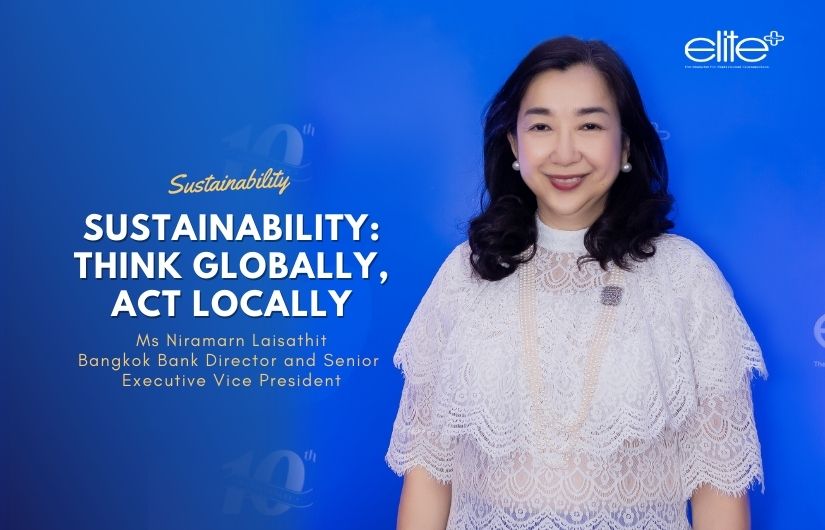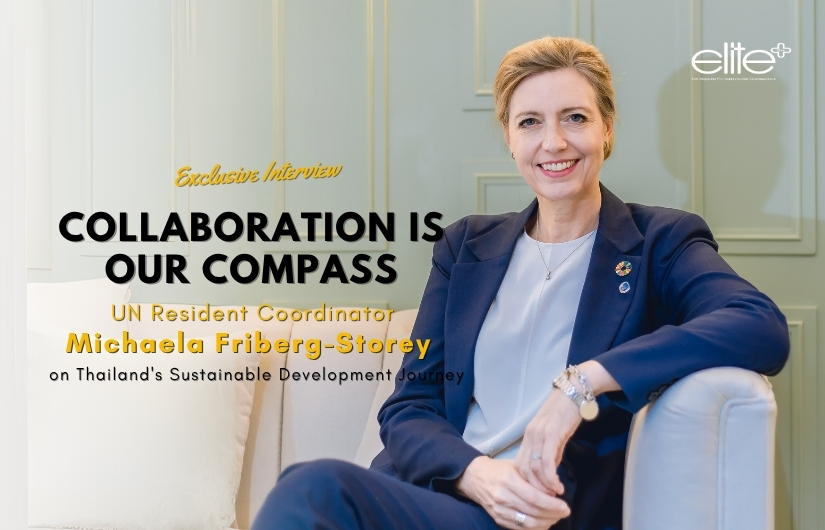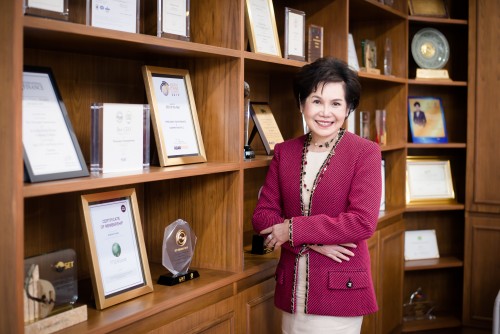Sustainability: Think Globally, Act Locally

Sustainability: Think Globally, Act Locally
This article is adapted from the keynote address presented by Ms Niramarn Laisathit, a Bangkok Bank Director and Senior Executive Vice President, at the Elite+ 10th Anniversary Gala Celebration.
Today, we are hearing the word sustainability more and more to cover a wide range of topics. So, what is sustainability? In 1987, the United Nations Brundtland Commission defined sustainability as “meeting the needs of the present without compromising the ability of future generations to meet their needs,” in other words, living our lives using resources without negatively impacting the lives of our children, grandchildren and future generations.
We don’t want them to face the apocalypses that are being portrayed in many of Hollywood’s blockbusters. What we do want is for them to grow up and live safely and happily. We want our children to have clean air to breathe, and we want to reduce and end harmful emissions, particularly PM2.5, that are already affecting our lives. We also want to ensure that our future generations have access to sufficient fresh water and food.
You must remember what we did yesterday impacts our lives today, and what we do today will impact our lives tomorrow. Therefore, we must act now!
In 2015, the United Nations launched the 17 Sustainability Development Goals, calling for action by all countries in a global partnership to promote sustainable development to ensure that our children and grandchildren can enjoy a quality life. They call for an end to poverty and other deprivations with strategies that improve health and education, reduce inequalities and spur economic growth, all while tackling climate change and working to preserve our oceans and forests.
Recently, the World Economic Forum released its Global Risk Report for 2024. The report provides an analysis of the looming challenges and risks shaping our global landscapes, and shows that people are becoming more concerned about our environment. Over the next ten years, attention will be focusing on extreme weather conditions, first and foremost, followed by critical changes to the earth’s systems, biodiversity loss, ecosystem collapse and natural resource shortages. After these come concerns come misinformation, AI and cyber insecurity. The report is now predicting a switch in people’s thinking, as currently misinformation, cyber security, economic downturns and world conflicts top the list.
Of course, people’s concerns are diversified, covering economics, geopolitics and social conditions. But in the next ten years, the majority of concerns will be environmental and technological. People feel they are now having a more immediate impact on the sustainability of earth, and this concern is valid.
We now see that climate change is upon us. It can be terrifying, and it is just the beginning. The United Nations Secretary-General António Guterres has said that the era of global warming has ended, and the era of global boiling has arrived.
It was confirmed that July 2023 was the hottest month in the past 120,000 years. The United Nations secretary-general also tweeted that the consequences are tragic with much of the devastation caused by heat; then swept away by monsoon rains. People were running from the rain. Workers were collapsing in scorching heat. He then called for action with many catastrophes occurring, resulting from greenhouse effects - the biggest floods in Belgium in over 50 years, the worst floods in 1000 years from rainfall in China, Hurricane Ida in the United States destroying more than one million households, the largest wild fires in 100 years in Canada, the largest floods in 115 years in Seoul, the largest floods in 100 years in New Zealand after nonstop rain for three days, and don’t forget the mammoth floods experienced by Bangkok in 2011.
Last year in Thailand, the increasing heat led to peak electricity consumption. In fact, this past February, electricity consumption hit 30,000 Mw, which normally happens during March or April. It has been forecas that this summer temperatures in Thailand will be one to two degrees Celsius hotter than last year and that peak temperatures will reach 43 to 44 degrees Celsius.
When it comes to species and biodiversity, when temperatures rise by 1.5 degrees, we will lose 6% of insects, 8% of plants and 4% of vertebrates. If the average temperature rises by two degrees Celsius, we will lose 18% of insects, 16% of plants and 8% of vertebrates, which means just a half degree increase can lead to a huge difference in these scenarios. In addition, it has been forecast that parts of seven Asian cities - Bangkok, Jakarta, Tokyo, Seoul, Hong Kong, Taipei and Manila - will be flooded by 2030.
So, you ask, how is the world responding?
The Kyoto Protocol in 1997 led to nonbinding emission reduction targets for 2015. Then, in 2015 the Paris Climate Accords led to a global climate deal adopted by 195 countries. After this in 2019, the European Union launched the European Green Deal, which aims to achieve climate neutrality by 2050. The famous CBAM – the EU’s carbon border adjustment mechanism –is also a part of the European Green Deal. And at COP 26 in 2021, many countries, including Thailand, made a commitment to mitigate global warming and set carbon neutrality and net zero targets.
When the EU announced that they will reach net zero by 2050, the United States said they hoped to reduce greenhouse gas emission by 50% within 2030 and reach net zero by 2050 as well. China expects its carbon dioxide emission to peak before 2030 and to achieve carbon neutrality by 2060. India announced it should achieve net zero by 2070.
Around the world, each country has, or is now, setting its own plan and goals. This is because each country is unique. We are different in terms of resources, structures and readiness. We need to take into account the social and economic needs of our countries that still need to be met.
Many developed countries are talking about scaling down coal fired power plants that have been operating for 40 to 50 years. The situation is very different here in Southeast Asia where 80% of our power plants burn fossil fuels. Many coal fired power plants have only been operating for ten to 15 years and decommissioning them now would be extremely costly in terms of investment and jobs. Consequently, although countries in our region have committed to making a transition to net zero, they are finding it difficult to meet those commitments, and fossil fuel will continue to be a very important part of the energy mix for some time to come. As a result, what each country can do and should do is different. There is no one size fits all pathway.
Thailand has targeted carbon neutrality by 2050 and net zero by 2065. Currently, 93 countries have communicated a net zero emission target, covering 78% of global emissions. COP 27 and COP 28 both fostered continuous development. While COP 27 focused on implementation, COP 28 started with a series of announcements and commitments.
Setting the scene to drive climate action and transition to action with a focus on mobilizing finance for Thailand, Pol Gen Patcharawat Wongsuwan, Minister of Natural Resources and Environment and a Deputy Prime Minister, reiterated that Thailand will honour its commitment towards carbon neutrality and net zero. He then explained that Thailand is revising its national action plans to cut emissions and adapt to climate impacts with expected peak emissions by 2025. Thailand is in the process of enacting its first Climate Change Act to regulate greenhouse gas emissions and enhance capacity for climate change adaptation in every sector. It has also revised its national adaptation plans to help combat the impact of climate change and build resilience.
After looking at how governments have responded, what about the private sector?
To begin with, Microsoft announced that by 2030, the corporation and its supply chain will be carbon negative. Amazon aims to reach net zero by 2040. Facebook is now using 100% renewable energy and aims to reach net zero for its global supply chains by 2030. Apple has targeted for its global supply chain to be Carbon Neutral by 2030. More than 250 production partners have agreed to cooperate. Meanwhile, Unilever aims to reach net zero by 2039. They look at the greenhouse gas impact of products in the whole supply chain, ranging from raw materials to manufacturing, logistics, distribution and packaging. This demonstrates that the world is getting serious about climate change and reducing greenhouse gas emissions. Companies are looking at their supply chains as well. As a result, if a company wants to stay relevant and in business, they need to be aware and take action.
They need to look at how they can improve their operations to reduce greenhouse gas emissions. They need to ask how they can source supplies. How can they make their product and services more environmentally friendly? In fact, by answering these questions, they can ascertain new opportunities in terms of their business.
Now, let's take a look at Thailand.
Let’s begin with Thailand's greenhouse gas emissions. In 2018, Thailand emitted about 372,000,000 tonnes of carbon dioxide emissions. The majority of these emissions came from the energy sector, which accounted for 69% of total emissions. The second sector was agriculture, accounting for 15%, followed by industrial processing and product use at 10% and waste at 4%.
_167261615.jpg)
Thailand is predicting it will reach its greenhouse gas emission peak in 2025, and then gradually decline to meet its carbon neutrality target in 2050 and net zero target in 2065. The majority of the reduction will be from the energy sector. We have to admit that greenhouse gas emissions cannot be reduced to zero, so to achieve carbon neutrality at net zero, we need to plant more trees to absorb and capture carbon. We also hope that new technologies can be developed to capture more carbon and reduce greenhouse gases according to nationally determined distribution, or NDC, which is a climate action plan for Thailand to cut emissions and adapt to climate impact.
There are four key measures to reduce greenhouse gas emissions. The first is to reduce greenhouse gases in energy and transportation by increasing the use of renewables, improving energy efficiency and increasing electric vehicles on the roads.
The Bank of Thailand has established a policy and guidelines to promote investment in green technologies and encourage innovations that are environmentally friendly including carbon capture, utilization and storage. They have also developed a taxonomy for industry to follow. This taxonomy is a classification system of economic activities deemed environmentally sustainable.
With taxonomy, financial sectors and investors can identify which activities are considered as contributions towards the country’s net zero goal. It can help the financial sector decide which activities they should channel funds to support transition towards a low carbon economy.financial sector decide which activities they should channel funds to support transition towards a low carbon economy.
The first taxonomy phase issued last year focused on two carbon intensive industries, energy and transportation. Currently, the Bank of Thailand is developing taxonomy phase two, which covers more industries, namely, manufacturing, agriculture, real estate and construction, together with waste management.
In addition, it is expected that the Climate Change Act will become law during the term of this current government. The key items in the Climate Change Act are greenhouse gas mandatory reporting, an emission trading scheme, carbon tax and carbon credits. The Government has also set up a programme to promote electric vehicles, or EVs, as part of the transition towards a low carbon economy. The government has launched a policy target in which they aim to have 30% of vehicles made in Thailand electric by 2030 as well as issued several measures to support the EV industry, EV manufacturing, EV usage, infrastructure and EV batteries.
The latest policy comprises EV 3.5 measures in which the Government provides subsidies for electric cars, pickups and motorcycles which meet specific criteria. This has already resulted in a significant increase in the share of EV car registrations from 0.19% in 2020 to almost 12% in 2023.
Currently, 576 organizations have joined Thailand Carbon Neutral Network. 98 are recognized as leading Climate Action organizations participating in greenhouse gas reduction through Thailand's voluntary emission reduction programmes, and they have expressed their desire to reduce their greenhouse gases further via low carbon technologies and innovation, including carbon capture in line with international standards and practices.
Now, to conclude, let’s look at what Bangkok Bank is doing. As a financial institution, we provide funding and advice to our clients to help them in the transition to lower carbon operations. We are the leading financier to the energy industries in Thailand, and many of our clients have offshore interests, not only in Southeast Asia, but also elsewhere in Asia.
The bank promotes investment in the renewable energy sector to create energy security and mitigate climate change by offering loans that support investment in the energy transition with electricity produced with renewable energy sources, both domestically and internationally. Projects include solar power plants, hydropower plants and wind power plants.
In addition to supporting sustainable development and helping our clients transition to a low-carbon economy, Bangkok Bank also provides special finance packages to customers such as Bualuang Green Solar Energy Loans to support clients in installing solar rooftops. We also have Bualuang Green Products, which was established for customers who would like to invest in renewable energy, waste management, reuse and recycling. And we have another product called Bualuang Transformation, a 20-billion Thai baht programme to support SMEs and facilitate their competitiveness and sustainable growth with a fixed interest rate of 5% per year.
Bangkok Bank is now a leader in ESG-bond underwritings in Thailand, and in the years ahead, we will be working to develop new tools and programmes to support Thailand’s pursuit to achieve its carbon neutrality and net zero targets.
List of references:
1. https://www.un.org
2. World Economic Forum’s Global Risk Report 2024
3. NCB news and https://www.activesustainability.com
4. Dr. Wijarn Simachaya, President of Thailand Environment Institute (TEI), Presentation to Thai Red Cross Society, 6 Feb 2024 5. Energy News Center 6. Thailand Greenhouse Gas Management Organization (Public Organization)

Elite + Editorial Team 586 Posts
Editorial Team





















































































































































































































































































































































































































































































































































































































































































































































































































































